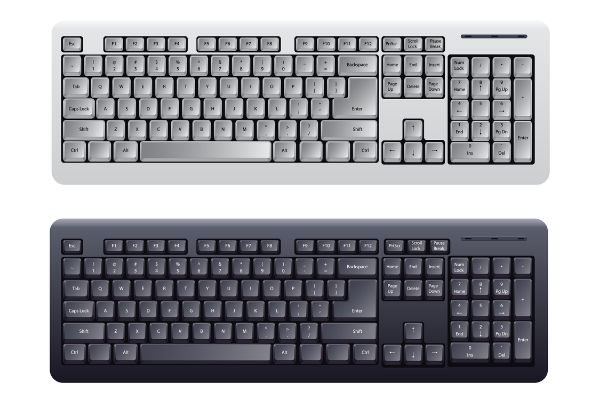Disclaimer: This post may contain affiliate links, meaning we get a small commission if you make a purchase through our links, at no cost to you. For more information, please visit our Disclaimer Page.
Computers perform a wide range of tasks for us today, and they cover both necessary business operations and entertainment functions. How we interact with them is one of the most important aspects of their operations, and developers have devised a number of convenient ways in which we might do this.
One of the main ways that you use is the Human Interface Device, otherwise abbreviated as just HID. As you might expect, these are devices that you use to interact with the computer and input information or commands. Human Interface Devices are similar to old PS/2 connectors, but this new classification uses generic USB driver support for more flexibility. Before HID, the protocols necessary for such devices were stricter.
The modern keyboard is one such device, but some users may notice a few strange things about theirs. If you look at your version of the HID keyboard in device manager, you may notice multiple instances of it.
We’ll talk about why this might be, how it works within Device Manager itself, and what happens if you uninstall a version of the HID keyboard that you find listed there. Furthermore, we can go over some common problems that might cause your keyboard to stop working properly.
Table of Contents
What Is HID Keyboard in Device Manager?
The Device Manager section of your computer provides a handy list that shows all of the hardware your machine is running. This might include any peripherals that are attached to the computer, such as a keyboard, mouse, or standalone camera.
You can access Device Manager in multiple ways, but one of the easiest paths is simply to search for it in the appropriate Windows search pane. It should come up after you’ve typed a few letters. You can look at all of the devices there once you are inside this section.
One of the main purposes of Device Manager is to allow for the tweaking of drivers that you might need to install, remove, reset, or update. You may have heard a lot about drivers already, and they are usually one of the things you’ll try to update or reinstall if a particular piece of computer hardware is not working as it should.
In essence, a driver is simply a set of files, and these files communicate with your computer’s operating system in order to tell the device listed there how it should behave. A keyboard’s drivers will tell it that it needs to type when you hit the keys, and this set of files makes sure that the appropriate symbols appear on the screen in order to match the keys that you press.
As we touched on, the HID standard is just a replacement for an older standard that we used to use for keyboards in the computing world. You should always see at least once instance of this listed in your Device Manager.
However, some users may notice that there is more than one HID keyboard once they expand the list, too. It’s important to understand some of the reasons why this might be, because you may need more versions of the HID keyboard than you might think.
Why Do I Have Multiple HID Keyboard Devices?
There could be a few reasons why you’ll see multiple HID keyboard instances listed in your Device Manager menus. We will cover a couple of the most likely reasons here. Our list may not be comprehensive, but it should represent the reasons for HID duplicates within the systems most people might use for daily tasks.
Depending on the rig you are using, one of the main reasons you might have multiple copies of HID keyboard showing up is to facilitate n-key rollover. N-key rollover scans each press of a key individually. In most keyboards that do not have n-key rollover, the computer itself will do this scanning.
This has a particular effect on which keys the computer might register and put up on the screen. For example, if you press several keys at once on a board without n-key rollover, the chances are good that not every key you pressed will show up as a character on the screen.
In short, you may type too quickly or press too many keys at once for the input to register smoothly. The purpose of n-key rollover is to eliminate this problem.
This feature can be particularly useful if you are using a gaming PC, as you may need to press several keys in rapid succession or in tandem to perform certain actions. With the rollover active, you should be able to do this in a way that completes the desired function successfully, even in a heated situation.
It may be possible to get this function to work without using multiple instances of HID keyboard within Device Manager. However, having more than one of these present can make the process easier. Without the copies, better HID support might be necessary before you could begin to implement the n-key functions.
It is important to note, however, that not all keyboards support n-key rollover. There are certain design or cost factors associated with it, and it is not always present on every model you come across.
One of the other main reasons that you might see several HID keyboards listed has to do with other peripherals. This is true even on keyboards that do not have n-key support. For example, a mouse might present itself as a HID keyboard.
This is more likely to be true if the mouse itself can support macros for a keyboard, but it is possible even in models that do not. Therefore, all of the HID keyboard entries that you’re seeing in your Device Manager may not relate to keyboards at all. Some of them are other peripherals that could be just as necessary to your interactions with your computer.
What Happens if I Uninstall HID Keyboard Device(s)?
What can happen if you uninstall a HID keyboard device depends on how many you have running in your system and what you know about them. Before we begin, it is important to remember that it is usually not a problem to have several HID keyboards listed. Typically, they refer to other things attached to your computer.
Even if they do not, the different versions should not be doing anything to compromise the effectiveness of your computer. There are some legitimate reasons to try uninstalling some of the HID keyboards you find, but they relate to devices not working as intended. We will cover some of these cases in a later section.
Sometimes, you can uninstall a HID keyboard and everything will keep working. If so, you may have uninstalled something that was running on the system unnecessarily.
You would need to check that all of your peripherals are still functioning as they should to be sure of this, though. If this turns out to be the case, you may have uninstalled some sort of copy that had no effect on your rig. You should be able to continue normal operations with your computer after this.
It is possible that you can find different versions of the HID keyboard reappearing in Device Manager, however. If this happens, it is very likely that the system has detected their absence and reinstalled them automatically. In such instances, it may be best to leave them as they are. The system has decided that these versions of the HID keyboard are performing necessary functions.
Lastly, the other thing that can happen is that your dedicated keyboard stops working. As you might imagine, this will make it hard to do much of the input that you need to do for your computer, and you may be limited to using only a mouse. If this happens, it means that you accidentally uninstalled the drivers for the main keyboard that your system recognizes.
This is why it is important to know what you’re doing when it comes to removing things in Device Manager. If this happens to you, you can get by with just rebooting the system, in most cases. Once the computer boots up again, it will detect that there is an issue with the keyboard drivers and reinstall them.
Why Is My HID Keyboard Not Working Properly?
There might be occasions where your keyboard becomes unresponsive. If you check in Device Manager, you may notice that there is a yellow exclamation mark next to at least one of the listings for HID keyboards.
This would mean that there is some kind of error going on with the files that tell the keyboard what it should do. There could be multiple reasons for this, but there are some fixes that you can try for general troubleshooting purposes.
How Can I Fix This?
The easiest way to try to resolve this issue is to uninstall and reinstall the drivers. You can do this by right-clicking on the affected HID keyboard and choosing the appropriate option. Once done, scanning for any hardware changes from within Device Manager itself should allow the system to reinstall those drivers.
This may work if the problem was a malfunctioning or corrupted driver. In other cases, you might be running older drivers that are not compatible with any recent system updates your computer has had. For this, you can check for and install appropriate updated drivers.
Conclusion
Keyboards are one of the main things that allow us to interact with and send signals to our computers. However, not all peripherals are keyboards, but they may still take on this designation in Device Manager. For the most part, there is nothing wrong with several versions of this entry running on your system, and they might all be tied to necessary hardware that you’re using on your computer. If there is a problem, addressing the drivers may help.


